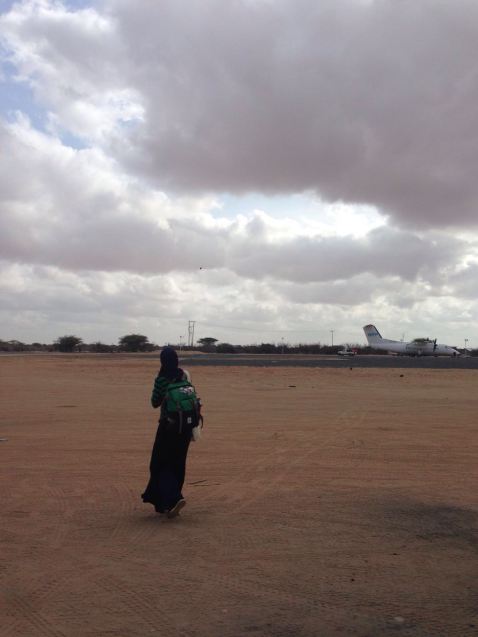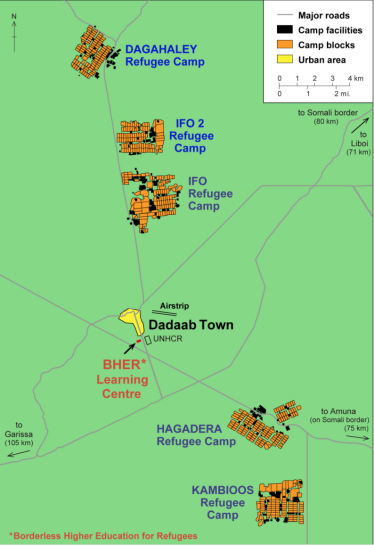BHER TA, Hawa Sabriye, writes about her journey into the BHER project, learning about Dadaab, and her reflections after the first week of her on-site field assignment.
.
Dadaab is a town located in the northeastern region of Kenya, roughly 90 kilometers east from the Kenyan-Somali border. In 1992, refugee camps were established in Dadaab as a temporary shelter for 90,000 civilians fleeing the civil war in Somalia. Today, Dadaab is host to over half a million refugees, making it the largest and oldest refugee camp in the world. The majority of its residents are Somali, as well as asylum-seekers from neighbouring African countries fleeing violence and insecurity. Today, Dadaab is divided into a complex of five refugee camps: Hagadera, Ifo 1, Ifo 2, Dagahaley, and Kambioos.
Prior to learning about all of these facts, I knew very little about Dadaab. Throughout my undergraduate and now graduate studies, I have been involved with the World University Service of Canada (WUSC) and I knew Dadaab only as a camp that some sponsor students use to call home. My friend and colleague HaEun Kim and I were offered the opportunity to be teaching assistants for York University’s Borderless Higher Education for Refugees (BHER) Project, which aims to make educational programs available in Dadaab for refugee students. The BHER team includes of a global group of NGOs and academic institutions, that apart from York, include Kenyatta University, Moi University and the University of British Columbia, who have come together and are committed to improving the quality and accessibility of education for refugees in Dadaab.
HaEun and I have just completed TA-ing a course for the winter semester through online learning for refugee students living in the Thai-Burma border, specifically in Mae Sot. Similar to York’s BHER Project, the Australian Catholic University (ACU) offers a Diploma in Liberal Studies in Mae Sot as well as in Ranong, for refugee students who have fled persecution in Burma and ended up in refugee camps in Thailand. Professor Don Dippo, co-founder of BHER, taught the course titled Educating for a Sustainable Future: A Blended, Integrated, Multidisciplinary Approach, in which both York University students and students in Thailand were enrolled in. The blended learning approach to pedagogy allowed for students in Thailand and in Toronto to learn together and to collaborate in addressing topics presented in the course. This TA experience gave us a small glimpse into what it would be like supporting students who are receiving their education from a refugee camp.
We were set to begin our 5-week task as teaching assistants, supporting the second cohort of students enrolled in BHER’s Teaching Certificate program. We were eager to meet our students and also nervous to embark on the daunting assignment of supporting a number of students who were coming from extraordinary and difficult circumstances. Would they trust us? Would we be able to connect with them outside of the classroom? Could we provide them with the academic support and guidance necessary for them to succeed?

Upon arrival, we were hit with a wave of heat we did not feel in Nairobi. Dadaab looked nothing like I imagined—extremely dry and dusty. We were driven to the Learning Centre, a campus built in partnership between the institutions and NGOs. We received a security briefing on the security measures that are in place within the UNHCR compound, where we would be living, and the Learning Centre, where we would be supporting our students daily. We quickly learned that we would not be able to move as freely as we hoped. Every location we went to was by a UNHCR car and we would always need to carry our badges that proved we were affiliated with the BHER, in order to receive access to where we would call home and work for the next five weeks.

Over this first week working and building relationships with students in Dadaab, we can already see first hand how important higher education in emergency zones are. Higher Education provides our students with a sense of self-dignity, pride, and confidence that allows them to manufacture hope for their future—one that is filled with endless possibilities if they are able to complete a post-secondary degree. 5 weeks is a short period of time, but we already know we will leave with stories and memories that will last us a lifetime. Through our posts we hope share our reflections on Dadaab, mobility, student experiences and what we hope for the future of higher education in emergencies.